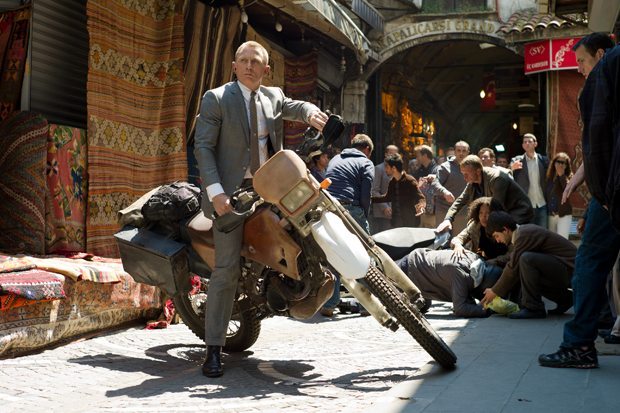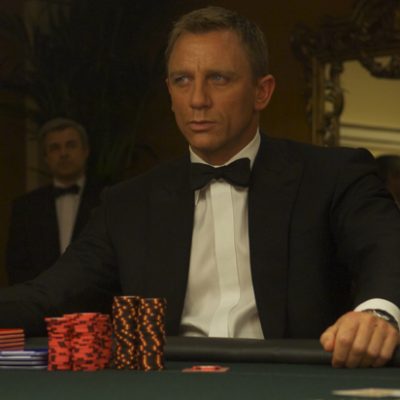The sixth and arguably most complicated Bond, on the grittier, more dated style of his latest 007 film Spectre, and whether it will mark the last time he dons the legendary tuxedo and Walther PPK
by susan hornik and Matt Scanlon
In its 53-year history, the James Bond film franchise has grossed a figure approaching $6 billion globally, and has racked up no fewer than 51 hours of blood sport, bikinis, and bombast in the course of 24 films. In all, six men have played the role of agent 007—Sean Connery, George Lazenby, Roger Moore, Timothy Dalton, Pierce Brosnan, and, of course, Daniel Craig. An impromptu Uzi battle might begin at any moment in selecting a favorite among the group, though it can be declared without much contradiction that Daniel Craig is the most cerebral and nearly inscrutable of the bunch. As measured by Bloomberg.com, Craig is also among the least lascivious, spending just 4.8% of his film time making propositions to nearby ladies (surprisingly, it’s Lazenby who maintained the most vigorous libido, with 10.5% of his cinema time on the make). He’s also in a dead heat with Dalton for the average number of managerial reprimands per film, each being chewed out an average of 3.5 times by the upper-echelon at the Secret Intelligence Service (SIS), more commonly known as MI6.
It might be a testament to our more metrosexual and wounded age that Craig seems to be carrying the deepest scars of the bunch, too, spiced with a not-quite-balancing degree of self worship (all seem to carry that latter proclivity in abundance).
It’s easy, though, to forget that there was no shortage of controversy surrounding Craig’s first turn as James in 2006’s Casino Royale, as there was a groundswell of fan lobbying at the time in support of Clive Owen donning the legendary tux (fresh as he was from his Sin City turn). While his first Bond didn’t break the bank in terms of profitability, grossing just shy of $170 million in its initial theatrical run after incurring $150 million in budgetary expenses (the opening parkour-laced chase sequence took nearly six weeks alone to film), Craig, who gained 20 pounds of muscle for the role, received a hearty dose of plaudits from critics, and convinced turnover-weary fans that a multiple-film-capable personality had once again inhabited the character. Even Moore was impressed; in a recent interview he said: “Daniel is a far grittier Bond. I think that makes him a more real Bond. I mean, he looks like a killer, whereas I look like a decrepit lover!”
Two films (Quantum of Solace and Skyfall) and $470 million more box office bucks in the till, and the Chester, UK-born 47-year-old was very much on a roll.
In the latest cinematic installment of writer Ian Fleming’s 11-book British spy series, Spectre, Craig dealt with the challenge of making this action flick even more vibrant than its predecessor.
“We wanted to be better than Skyfall, he said at a press event promoting the film. “It is as simple as that. We didn’t have a choice; we had to be bigger and better. With Skyfall, we set something in motion, but we wanted to go a bit further with it and experiment more….the desire to go to more places, to get more texture and color and atmosphere into the movie. And since Skyfall was more Londonbased, we wanted to expand and explore.”
As directed by Sam Mendes, Bond is once again doing battle with the criminal organization SPECTRE (Special Executive for Counterintelligence, Terrorism, Revenge, and Extortion), this time personified by Oberhauser, played by Christoph Waltz.
“Having SPECTRE in the film opens up lots of avenues for us,” added Craig. “Having this organization allows us to be traditional, while also bringing in something very new….It is one of the most exciting parts of this movie.”
The $300-million-budget film also utilized a more vintage feel.
“We worked with a slightly different style from the other Bond films I’ve done,” the actor explained. “This one is very individual, but also hearkens back to a little of what has gone before in the Bond films of the ’60s and ’70s….We spent two years getting this together and there has been so much hard work and effort…it’s very exciting.”
Every location featured impressive stunts and set pieces, starting with Day of the Dead scenes in Mexico City, which employed 1,520 extras, dressed and made up by no fewer than 107 make-up artists (98 of whom were local). On each working day it took three and a half hours just to get the crowd prepared. The filmmakers also shot in three different locations in the city—The Gran Hotel, Plaza Tolsá, and the Zócalo, the last being the main square. The stunt team replicated a massive explosion involving the hotel at Pinewood Studios in England, although the Zócalo itself played host to a massive sequence involving an out-of-control helicopter piloted by Red Bull aerobatic pilot Chuck Aaron.
Craig was quick to add that he loved the exotic shoots.
“Mexico City is another one of those places that is just so visually stimulating,” he offered. “And Rome, of course, is one of the most beautiful cities in the world…We also started at the top of a mountain in Austria and got all the way down to the bottom with airplanes and four-wheel-drives and explosions.”
Production took place in the Austrian locales of Lake Altaussee, Obertilliach and Sölden, the last the home of the ICE-Q restaurant and the cable cars that feature in a tense sequence with Q (played by Ben Whishaw).
Craig reported that he also enjoyed seeing how the arc of his character hasevolved over the course of the past few films. “He has gotten older and wiser,” he observed. “That for me is a great pleasure to explore, and not stick him in one place.”
Sticking may ultimately proved to be a sticky issue for fans, as speculation abounds that Spectre is going to be the actor’s last turn as 007, and Sam Mendes confirmed in November that it would be his last time in the director’s chair (he also helmed Skyfall). At press time, Craig would neither confirm nor deny, instead offering tantalizing uncertainties during a fall interview with Esquire.
“I don’t know. I really don’t know. Honestly. I’m not trying to be coy. At the moment, I can’t even conceive it,” he said. “I have a life and have got to get on with it a bit, but we’ll see.”
Spectre producer Michael G. Wilson added a bit of sauce for the rumor goose in early November when he told the Hollywood Reporter, ”I think we’ve got Daniel Craig” slated for a 25th film, though he acknowledged that “We don’t have a contract.” If the answer is ultimately no, it’ll be a comparatively off year for the actor, who has no other even preproduction projects currently slated for 2016.
Daniel Wroughton Craig was born on March 2, 1968, in Chester, England. Growing up near Liverpool, he enjoyed going to the theater with his family (many of his mother’s friends were actors, and he felt drawn to their world). Craig moved to London when he was 16 to join the National Youth Theatre, and then studied at the Guildhall School of Music and Drama. After graduating, he made his film debut in The Power of One (1992), a 1950s drama set in South Africa, but became better known for his role in the 1996 BBC miniseries Our Friends in the North. The serial drama enjoyed widespread acclaim and won many awards in the year following its broadcast, including two British Academy Television Awards, two Royal Television Society Awards, and four Broadcasting Press Guild Awards.
In 1998, he co-starred in the film Love Is The Devil, a biography about the artist Francis Bacon, playing Bacon’s lover George Dyer, a small-time thief. (Craig later described the project as “the first film I did that ‘made me.’”) He also had a small role in the historical drama Elizabeth, released that same year.
In 2001, the actor appeared as the romantic interest in the action film Lara Croft: Tomb Raider, based on the popular video game, then gave a standout performance in 2002’s Road to Perdition, playing Connor Rooney, the murderous son of a mob boss. What followed was a demonstration of range when he starred as poet Ted Hughes in the drama Sylvia (2003), a work that explored the life of Hughes’s wife, poet Sylvia Plath, and the couple’s fraught relationship.
He made his debut as a leading man playing an unnamed character (referred to as “XXXX” in the credits) in the 2005 crime drama Layer Cake. That same year, Craig got a chance to work with veteran director Steven Spielberg in the drama Munich, followed by a memorable role in the 2011’s The Girl With the Dragon Tattoo, the American adaptation of the Swedish film based on the bestselling novel. He also lent his voice to Spielberg’s The Adventures of Tintin, based on the popular comic books, and also starred in Cowboys & Aliens and Dream House.
Married to actress Rachel Weisz since 2011, Craig is also an accomplished stage performer, who in 2013 starred in the critically acclaimed Broadway show Betrayal opposite Rafe Spall and Weisz. (Directed by Mike Nichols, the play ran for 14 weeks and grossed $17.5 million.) He has most recently signed on to play Iago in an off-Broadway production of Othello. The play will be staged by New York Theater Workshop, a prestigious but small nonprofit theatre that plans to present the work for a limited run in the fall of 2016.









